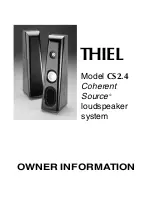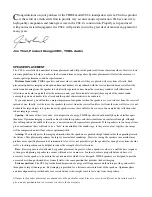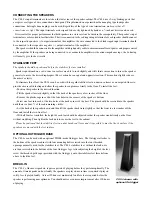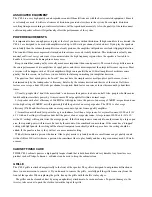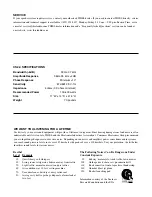
C
ongratulations on your purchase of the THIEL model CS2.4 loudspeaker system. This fine product
is the result of a dedicated effort to provide very accurate music reproduction. We have used very
high quality components and taken great care in the CS2.4’s construction. Properly set up and used
with good associated equipment, the CS2.4 will provide you with a great deal of musical enjoyment for
many years.
SPEAKER PLACEMENT
The CS2.4s are relatively noncritical to room placement and will provide good results from almost anywhere. However, here
are some guidelines to help you achieve the best sound from your speakers. Speaker placement will affect the accuracy of
timbre, spatial performance, and bass performance.
Distance from walls:
THIEL speakers, and most others, sound best if they are placed well away from all walls. Such
placement optimizes imaging and depth, and musical timbres are reproduced with the least coloration because it allows the
initial sound coming from the speaker to be distinctly separated in time from the secondary sound of wall reflections. If
reflections are heard too quickly after the primary sound, your brain tends to interpret them as part of the initial sound,
causing the perceived timbre to be altered and the spatial characteristics to be confused.
If you experiment, you will notice a major improvement in openness when the speakers are even two feet from the rear wall
instead of one. Ideally, we like to see the speakers three feet from the rear wall and five feet from the side wall. Also, it is not
desirable for large objects to be placed near the speakers since these will also be a source of unwanted early reflections that
reduce imaging accuracy.
Spacing:
Because of their very wide, even dispersion of energy, THIEL speakers should usually be placed farther apart
than most. Optimum imaging is usually achieved when the speakers and the listener form an equilateral triangle, although
this will depend on the width of the room—a narrow room will require closer placement. If the speakers are too far apart for a
given environment, there will tend to be a “hole” in the middle of the sound stage; if they are too close together, the image
will be compressed and will not achieve optimum width.
Aiming:
We usually prefer the imaging obtained when the speakers are pointed straight ahead rather than pointing toward
the listener. This placement produces the largest, most natural soundstage. However, toeing the speakers in somewhat may
produce more specific placements of instruments. Also, if it is not possible to get the speakers far enough away from the side
walls, a toed-in position can be helpful to reduce the strength of wall reflections.
Bass:
Bass response is also affected by speaker placement. In general, when a speaker is close to a wall the bass response
is stronger and placing a speaker in a corner will make it even more so. In order to achieve properly balanced bass, it is
necessary for the speaker to be used in the environment for which it was designed. THIEL speakers are designed to provide
accurate bass when positioned away from all walls—the same position that provides the best imaging.
Listener position:
The CS2.4s provide broad dispersion of energy at all frequencies and therefore provide good results
throughout a large listening area. Best imaging is provided for a listener centered in front of the speakers. Optimum phase
and time alignment is provided only for a seated listener who is eight or more feet away from the speakers.
All aspects of speaker placement are dependent on the particular room. Since every room is different, no hard rules can be
given, and experimentation is necessary to achieve the best results.
Jim Thiel, Product Design/CEO, THIEL Audio

